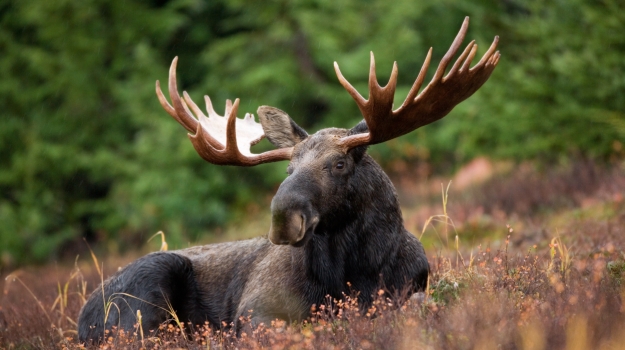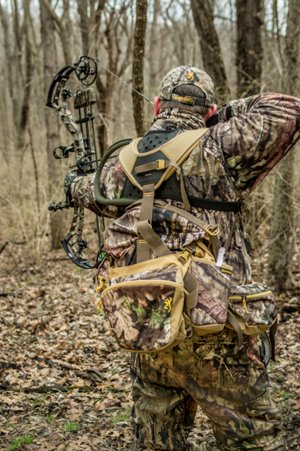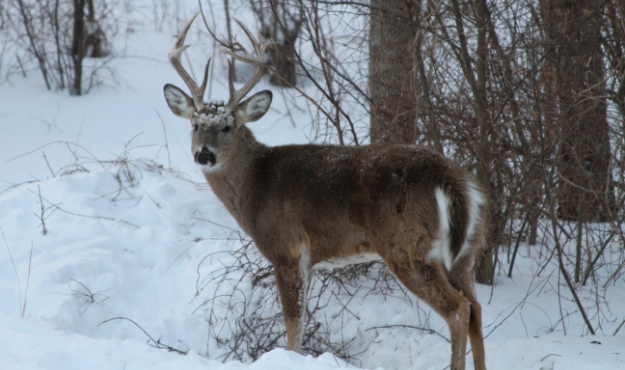
Editor’s Note: Brent Lafreniere lives in Williamstown, Vermont, and has been a Vermont resident his entire life. He’s been a Mossy Oak Pro Staffer for 6 years, has hunted deer for 25 years and hunts primarily public lands. “I’m a real fan of Mossy Oak Bottomland, but in the newer patterns I like Mossy Oak Break-up Infinity because I can use it not only for deer season but also for turkey season.” Because of winter deer kill and loss of habitat, the area where Lafreniere hunts is a really-difficult place to see or take deer. However, while hunting for 21 seasons in Vermont, Lafreniere has taken 19 deer. Because he’s such an avid hunter, he also travels to other states where deer season is open when Vermont’s season is closed, and where he can see and take more deer.
In Vermont has a lottery for moose tags. The person who draws the tag is the shooter, he can invite a second shooter to go with him, and they can pick a third person to be their guide. The guide doesn’t necessarily have to be a paid guide. I’ve been fortunate enough to go on four moose hunts either as a guide or as a shooter. Three of those hunts were unsuccessful, but I was fortunate enough to go on one successful moose hunt. I drew a permit in 2012 but didn’t take a moose. The season is only about 5-6 days long. On my hunt, we saw three moose. We jumped one up, and I couldn’t get a shot. We saw a cow moose cross the road in front of our truck. We jumped a second bull that got into the woods before I could get off a shot.
About 3 years ago, the Vermont Department of Fish & Wildlife allowed 50 moose tags for archery hunters, which would take place 2 weeks before the firearm season for moose. The first year of this special archery moose hunt, a friend of mine, Brian Hyde, invited me to go on his moose hunt with him as a shooter. He decided not to have a guide, so on the first day of the hunt we chose to hunt the northern zone, which was known to have a good population of moose. My uncle allowed us to stay at his home. We went up early, scouted, hung trail cameras and located a spot that we thought would produce a moose. We got trail camera pictures of three different bulls. We had a trail camera picture of one of the bulls raking the velvet off his antlers right in front of the trail camera.
 On the first morning of moose season, we went out early. On the way to the place we planned to hunt, a cow moose ran across the road in front of us. We parked our truck on the main road and then hiked in on an old logging road to a skidder trail that led to a log landing (clearing). We didn’t want to walk into the clearing because there were a lot of moose tracks there. As we walked down the trail, my friend was spraying Moose Bomb, an aerosol moose attractant. We came to a fresh wallow and decided to wait there for a while. We heard a cow moose calling, and I started calling back to her. As the cow came to us, we heard the grunting of a bull moose behind her. We were standing in some spruce trees off the trail the moose used to come to the wallow. When the grunting got close, my friend Brian stepped out of the spruces to look up the trail. He quickly turned back toward me with eyes as wide as dinner plates. “He’s really big!” Brian said. I stepped back to look at the moose and told Brian, “Wow!” I started grunting to the bull, but the bull wouldn’t commit to come to us.
On the first morning of moose season, we went out early. On the way to the place we planned to hunt, a cow moose ran across the road in front of us. We parked our truck on the main road and then hiked in on an old logging road to a skidder trail that led to a log landing (clearing). We didn’t want to walk into the clearing because there were a lot of moose tracks there. As we walked down the trail, my friend was spraying Moose Bomb, an aerosol moose attractant. We came to a fresh wallow and decided to wait there for a while. We heard a cow moose calling, and I started calling back to her. As the cow came to us, we heard the grunting of a bull moose behind her. We were standing in some spruce trees off the trail the moose used to come to the wallow. When the grunting got close, my friend Brian stepped out of the spruces to look up the trail. He quickly turned back toward me with eyes as wide as dinner plates. “He’s really big!” Brian said. I stepped back to look at the moose and told Brian, “Wow!” I started grunting to the bull, but the bull wouldn’t commit to come to us.
When we had been scouting this area, we had found a winter kill moose that had died the year before. I had taken the shoulder blade from that decomposed moose to use on this moose hunt. When the bull wouldn’t come to us, I raked trees to sound like a bull with that shoulder blade. That raking sound really fired-up the bull, and he walked the trail, coming straight to us. We ducked back into the brush, thinking that Brian would get a 10-yard shot, if the bull continued to walk down the trail to us. The bull stopped short of the place where Brian could get a shot and then walked away from us. I grunted again, and the bull turned and started walking straight toward us, stopping about 50 yards away before turning to walk away from us. Brian aimed, released the arrow and hit the bull a little in front of the bull’s hindquarter. I didn’t take a shot because I didn’t want to shoot Brian’s moose. We backed out, left the area and didn’t return for 3 hours.
Later we came back, began to stalk the moose and came out into a clearing. I saw something that looked like a moose antler. I showed the antler to Brian, and just then the moose stood up. Brian took a shot, and his arrow went under the moose’s belly. We backed-out again and returned later in the morning, split up, each of us walking down a different moose trail hoping to find Brian’s moose. The wind was blowing, and rain was coming down. I thought I heard two tree limbs hitting together. When I looked in that direction, I saw the bull not 10 yards from me on the ground, moving his head around with his antler hitting a tree. I drew my bow and put a shot in the bull. Then Brian came over and put the kill shot on that big moose. We were really excited that we’d gotten a moose on the first day of the first-ever archery moose hunt.
We went back to my uncle’s house, and his neighbor had a draft horse. Because the weather was extremely cold, we returned the next day with the draft horse and drug the moose out of the woods. The moose had a 53-1/2-inch spread. For 2 years, this moose was the state record, based on antler spread, for a moose taken by archery and weighed 833 pounds, field dressed.
Understanding Brent Lafreniere’s Technique for Hunting Public Lands
Remembering How Brent Lefreniere’s Bowhunting Career for Deer Began



























